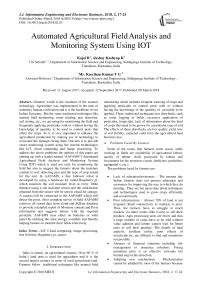Automated agricultural field analysis and monitoring system using IOT
Автор: Kajol R., Akshay Kashyap K., Keerthan Kumar T. G.
Журнал: International Journal of Information Engineering and Electronic Business @ijieeb
Статья в выпуске: 2 vol.10, 2018 года.
Бесплатный доступ
Smarter world is the resultant of the smarter technology. Agriculture was implemented in the nine of sedentary human civilization and it is the backbone of our Indian Economy. But the same traditional techniques like manual field monitoring, water feeding, pest detection, soil testing, etc., we are using for monitoring the field and frequently applying pesticides with or without having the knowledge of quantity to be used to control pests that affect the crops. So it is very important to enhance the agricultural production by making use of technology to overcome the damages being done. Our aim is to provide smart monitoring system using the current technologies like IoT, cloud computing and image processing. To address the above problems the authors of this paper are coming up with a model named “AAFAMS”( Automated Agricultural Field Analysis and Monitoring System Using IOT) which is used not only for monitoring the field but also to suggest the farmers about the moisture content in soil, detecting pest and the type of crop suited for the soil. In AAFAMS, a line follower robot is developed by using a hardware kit called Raspberry pi, which monitors the soil moisture level at every 100m distance using a soil moisture sensor and the information obtained from the sensor will be sent to cloud for storage. A camera will be connected to the AAFAMS which will detect the pests. After complete survey of field AAFAMS retrieves all stored data from cloud and SQLite database to provide a detailed report of Moisture content and Pests information and suggests farmer with the required pesticide. AAFAMS runs either on batteries or solar panel by utilizing the solar energy available and thereby helping farmers to monitor their fields effectively.
IoT, Cloud computing, image processing, line follower, Raspberry pi, sensor
Короткий адрес: https://sciup.org/15016125
IDR: 15016125 | DOI: 10.5815/ijieeb.2018.02.03
Текст научной статьи Automated agricultural field analysis and monitoring system using IOT
Published Online March 2018 in MECS
India is mainly an agricultural country. Over 60 % of India’s land area is used for agriculture and it is the second largest country in terms of total agricultural land. Farmers follow traditional techniques like manual field monitoring which includes frequent watering of crops and applying pesticides to control pests with or without having the knowledge of the quantity of pesticide to be applied. These traditional techniques has drawbacks such as water logging in fields, excessive application of pesticides, fungicides, lack of information about the kind of crops that need to be grown for a particular type of soil. The effects of these drawbacks are low quality yield, loss of soil fertility, expected yield from the agricultural land becomes less.
-
A. Problems Faced By Farmers
Some of the issues that farmers come across while working in fields are availability of agricultural labour, quality of labour, skills possessed by labour and investment for the resources (seeds, fertilizers, pesticides, equipment’s, etc.).
The problems faced by farmers are:
-
• Lack of education/awareness - The present day Indian farmers does not possess education and awareness for improving the way in which they do farming. They are not up-to-date about techniques and technologies used to grow crops efficiently and economically.
-
• Poor infrastructure - Almost 70% of land is not irrigated. Road connectivity to markets is poor. Thus, the farmers have to struggle to reach markets via other routes (like rivers) to sell their produce. Agro processing units are fewer and thus a large number of crops have to be sold without value addition and farmer cannot wait for better rates to sell their produce. The details of land analysis, fertilizer utility, poor effects of insecticide etc, are difficult to find and sometimes not possible.
-
• Absence of financial solutions including risk management or insurance solutions. Fixing minimum price is an effective welcome but limited step in this direction.
-
• Adopting new mechanisms - Mechanization cannot be adopted by most of the farmers because
of less affordability. Most of the farmers possess a very small agricultural holding. Thus, the land size is a constraint for directing the machines in the fields. In case of failure of equipment, service points are far off the field and they have to take their equipment to distant places for service. This leads them to borrow huge funds from unorganized sectors. Lack of insurance protection on self-sustainable business model further adds to their problem.
-
B. Difficulties in Manual Farming
The difficulties faced by farmers in manual farming are many.
To name, few are:
-
• Determining pests emerging on crops - It is difficult to determine the type of pest that attack a particular kind of crop and the formation and growth of pests because the farmer should have detailed knowledge on insect life cycles and habits [11][12].
-
• Amount of pesticide that is to be applied as per the requirement: When used judiciously, pesticides can protect plants from damage caused by pests. However, when used injudiciously, plant injury may occur, pests may not be controlled, domestic animals, human beings, natural enemies of pests that affect the crop and other forms of life are prone to health hazards. Health hazards are due to the unwanted contamination of environment, food and water bodies caused by injudicious use of pesticides [11][13].
It must be verified that the pest that is chosen by farmer to control is really going to cross the economic threshold level (ETL). The density of pests which causes control measures to be applied is called Economic threshold level. Sometimes in certain parts of field, crop is attacked by few insects-pests and adequate number of natural enemies of that pest is active or the economic injury to the crop may be caused by the pest. This provokes the farmer to take the decision of applying pesticides. In both the cases, the decision of using a pesticide may be wasteful and result in unnecessary accumulation of the pesticide in the environment. An advisable thought is that using economic threshold level of the pest, first measure the damage caused by a particular pest before using proper pesticide against it.
-
• Types of pesticide to be applied - First step to be followed in selecting a pesticide is the identification of the organism correctly (e.g., the specific weed, insect, or plant disease) that causes the problem. Various ways in which damage may be caused by the insects to the crop are cutting of seeds, tubers of underground stem, roots, tunnel in branches or stem, defoliate the crop plant, sucking of cell sap from leaves, stem, fruits and inflorescence and also transmission of different
viral diseases in the plants. Sometimes crop may be associated more than one disease and insect species. Various kinds of pesticides may be required to fight against such a condition. Therefore, it is essential to know all these things precisely before choosing a proper pesticide for an individual involved in pest control. The pesticides which cause least risks to environment, non-target species and the human health must be selected. Usage of same pesticide repeatedly causes development of resistance in pest against the pesticide. Hence, before the actual appearance of the resistance it is advisable to change the pesticide. Only in recommended situations restricted use of pesticides can be made. [11]
-
• Amount of water that is to be supplied to the fields - Several factors such as rainfall patterns, climate, plant type and size, microclimate and density are necessary in determining plant irrigation needs. Evapotranspiration (ET) method may be used to estimate water requirements. (The compound affect of evaporation of water from the soil and water used (transpired) by the plants is called Evapotranspiration, or ET) [10]. Following details are required for Evapotranspiration (ET) method:
-
I. The area of the plant in square feet.
-
II. The Species Factor of the plant.
-
III. The ET Rate for your area.
Area = π (3.14) x Radius squared = plant square footage.
To calculate the average moisture content in the field for every 100m distance we use the formula:
M avg = (M 1 +M 2 +……+M n )/n (1)
Where in equation (1), M 1 , M 2 , M 3 ,… M n are the moisture content detected at every 100m distance from soil moisture sensor.
-
II. Motivation
The consequences of problems faced by farmers are low quality yield, loss of soil fertility, water logging, etc., due to excessive supply of water and less quantity of expected yield. This motivated us to plan the development of “AAFAMS” (Automated Agricultural Field Analysis and Monitoring System) which monitors fields in an automated, cost effective and smarter way to help farmers. AAFAMS is an idea of building an agricultural robot. It is a Line Follower robot which monitors the field in a smart way. This would help in monitoring the agricultural fields of the farmers by detecting pests (if any), moisture level in soil, suggesting the required pesticide applicable to the identified pests and these information are sent to cloud for storage. It also uses an image processing algorithm to detect the presence of pests. The data in the cloud is processed and if the pests are present then the required pesticides will be recognized. The processed information will be sent to the farmer in the form of a report through an Android Application.
This model also provides an information about the crop rotation system to farmers so as to improve the multi-crop based agriculture which will enhance the fertility of soil and reduce the effect of pests on crops.
-
III. Objective
To simplify the task of farmers we plan to develop a model which would be helpful in monitoring the fields, detecting pests in the crops and it reduces the task of manually judging the field by the traditional technique. AAFAMS is an automated robot therefore it doesn’t require any human intervention and it is an intelligent system which monitors fields automatically. The model uses raspberry pi and sensors to retrieve information and it will provide accurate results. To make effective use of natural resources the solar panel is used for energy supply and it reduces cost when compared to electrically battery operated device as well as helps to get more yield.
-
IV. Literature Survey
Many ideas went behind to design a system to automate the traditional techniques. A number of research was made and taken into consideration to come up with a model like AAFAMS which would not only detect the pest and moisture content in soil but also provide a report to the farmers through an android application as shown in figure 1.
-
A. Role of IOT in Agriculture
IoT stands for Internet of Things where things are connected to the network so as to automate the working of things efficiently and reducing the human work. IoT is used as one of the platform where many agricultural works are being done and is taking place so as to help farmers from toiling at fields. There are systems that are proposed in agricultural aspect of IoT which are crop water management, Precisionhawk’s UAV Sensor platform, etc.
The paper we referred was “The Internet of Things in Agriculture for Sustainable Rural Development” [1] by Nomusa Dlodlo and Josephat Kalezhi stated about the IoT and needs of IoT for the domains like forestry, weather forecasting, crop farming, livestock farming, wildlife management, rural financing and market identification. The disadvantage of the idea presented in “Ref. [1] ” is that knowledge of IoT and technologies is must for farmers to apply these concepts in their fields for farming and its related activities.
-
B. Pest Detection
Image processing is one of the different subject when compared to IoT. Ever imagined how this topic of discussion can be driven towards the agricultural aspect?. The image of the crops in the field can be used for detection of any pest present in the crops and hence helping farmers from a greater lose that might have to be faced due to the pests. The paper we referred was “A Novel Cloud Computing based Smart Farming System for Early Detection of Borer Insects in Tomatoes” “Ref. [2]” by Sudhir Rao Rupanagudi, Ranjani B. S., Prathik Nagaraj, Varsha G Bhat and Thippeswamy G. The main focus of this paper was to detect the pest named borer in the tomatoes using the available detection methodology. The disadvantage of the idea presented in “Ref. [2]” is that only specific kind of pest (borer) is detected only in a single crop (tomato). It is not helpful for determining different pests in multiple crops. For implementation purpose we are using the “Fast and Accurate Detection and
Classification of Plant Diseases” “Ref. [3]” by H. Al-Hiary, S. BaniAhmad, M. Reyalat, M. Braik and Z. ALRahamneh. This paper presents the idea which has the accuracy of 94.33% for multiple crops in a field. But it has more accuracy when it comes to individual crop which is 99.66%, hereby providing an efficient way to detect pests in multiple crop and individual crop in agricultural fields. The idea in “Ref. [3]” fails in estimation of the severity of the detected disease caused by pests.
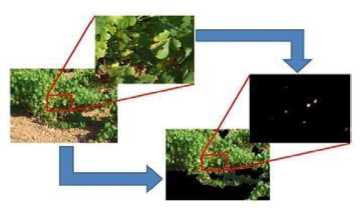
Fig.1. Pest Detection and Identification
-
C. Cloud Computing
Cloud computing is a type of Internet-based computing that provides shared computer processing resources and data to computers and other devices on demand. Cloud is a platform to store data. This can be used for storing of information of the data obtained after the detection of pest and then used for future processing and giving report containing the type of pest that can be used for the detected pest as shown in Figure 2. The paper we referred was “Framework to Leverage Cloud for the Modernization of the Indian Agriculture System” “Ref. [4]” by Anupriya Tuli, Nitasha Hasteer, Megha Sharma and Abhay Bansal. The idea is to provide information assistance related to agriculture to those farmers living in rural areas. The discussion of the existing system of government services and the mobile services is stated and the additions that can be done to these existing systems to reduce burden on farmers is also being stated. The disadvantage of idea proposed in [4] is that it’s not cost effective, with the technological advancement and improvement in financial conditions of Indian farmers, technologies like IOT (sensors, RFID’s, etc.) can be inculcated in proposed model “Ref. [14][15]”.
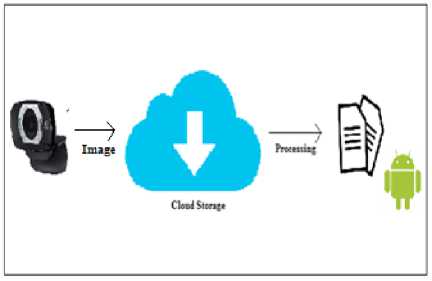
Fig.2. Usage of cloud
-
D. Dropbox
Dropbox is a file hosting service that offers cloud storage, file synchronization, personal cloud, and client software. It creates a special folder on the user's computer, the contents of which are then synchronized to Dropbox's servers and to other computers and devices that the user has installed Dropbox on, keeping the same files up-to-date on all devices. Where users are offered a free account with a set storage size, with paid subscriptions available that offer more capacity and additional features. Dropbox Basic users are given 2 gigabytes of free storage space. Dropbox Plus users are given 1 terabyte of storage space, as well as additional features, including advanced sharing controls, remote wipe, and an optional Extended Version History add-on. the features of dropbox as listed below:
-
• Everything in Standard
-
• Advanced admin controls
-
• Tiered admin roles
-
• Audit logs with file event tracking
-
• Invite enforcement
-
• Single sign on (SSO) integration
-
• Device approvals
-
• Business hours phone support
-
• Enhanced monitoring and reporting tools
-
• Third-party App Integration
-
• Remote Wipe
-
• Live support
-
E. Line Follower Robot using Raspberry-pi
The Raspberry Pi is a series of credit cardsized singleboard computers. It can be used to develop a robot which travels through a particular line and the coding is done using python language and the code is dumped into raspberry pi using putty “Ref. [16]”. The paper we referred was “Design and Implementation of Autonomous Car using Raspberry Pi.” [5] By GurjashanSingh Pannu, Mohammad Ansari and PrithaGupta. The paper proposes a system in which a car is designed which would reach the given destination. The car also includes some algorithms which are used for lane detection, obstacle detection for providing the necessary control to the car. The disadvantage of using the idea proposed in [5] is its reduced efficiency by unnecessary calculations of the regions which are already known or familiar.
-
F. Android Application
Android is a mobile operating system installed in devices like smart phones and tablets. There are millions of applications and games available to the users from the Google Play store. Android comes with different versions with new improvements. The different versions of android are named after the name of a sweets and desserts in alphabetical order. The version names are cupcake, donut, eclair, froyo, gingerbread, honeycomb, ice cream sandwich, jelly bean, kitkat, lollipop, marshmallow and nougat. The android application is developed using Android Studio which is an official integrated development environment and is open source software. Android Studio is user friendly and easy to understand because of the availability of different features.
-
G. Solar Panels
Solar panels are rectangular panels that are designed so as to absorb sun’s rays as a source of energy for generating electricity or heating. A solar panel is a collection of solar cells. Solar cells are made of semiconductor such as silicon. They are attached to a circuit using a wire shown in Figure 3. When light strikes the semiconductor, light energy is converted into electrical energy. This electrical energy flows through circuit. The solar cell stops producing power as soon as light is removed. Huge number of small solar cells spread over a large area can work together to provide enough power to be useful.
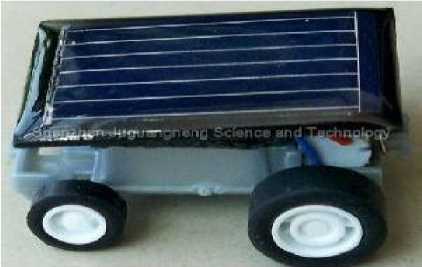
Fig.3. Solar Panel
-
H. SQLITE
SQLite is a very simple in-process library that implements a self-contained, serverless, zeroconfiguration, transactional SQL database engine. In short, SQLite is a library used for dealing with local relational database and it is embedded into the end program. The programming language support to SQLite are C, C#, C++, Java, etc. The advantages of using SQLite are as follows:
-
i. File based
-
ii. Great for developing and even testing
-
iii. Language extensions
-
iv. Better performance
-
v. Reduced application cost and complexity
-
vi. Portable
-
vii. Reliable
-
viii. Accessible
-
I. Ultrasonic Sensor
Ultrasonic distance sensors are designed to measure distance between the source and target using ultrasonic waves. We use ultrasonic waves because they are relatively accurate across short distances and don’t cause disturbances as they are inaudible to human ear. HC-SR04 is a commonly used module for non-contact distance measurement for distances from 2cm to 400cm. It uses sonar (like bats and dolphins) to measure distance with high accuracy and stable readings. It consist of an ultrasonic transmitter, receiver and control circuit. The transmitter transmits short bursts which gets reflected by target and are picked up by the receiver. The time difference between transmission and reception of ultrasonic signals is calculated. Using the speed of sound and equation,
Speed = Distance/Time
HC-SR04 ultrasonic distance sensor module has four pins:
-
• VCC – 5V, input power
-
• TRIG – Trigger Input
-
• ECHO – Echo Output
-
• GND – Ground
-
V. Highlevel Design of Model
AAFAMS has different modules as shown in figure 4 Firstly the moisture sensor in the device senses the moisture content from the soil at every 100m distance and the camera takes a video. Frames from that video are chosen and is processed using image processing algorithms to detect the pest. All the information from the sensor is sent to SQLite database and from camera is sent to dropbox cloud storage.
Later the images stored in dropbox are fetched to find the type of pesticides that needs to be applied to prevent the pest in the crops. The information about the moisture content in soil, pests detected in crops and the type of pesticide that is to be applied to prevent the damage of crops from the pests is displayed to the farmer using an android application. The application will contain a complete report of the above mentioned information.
The circuit connection in AAFAMS is as shown in the figure 5 An array of IR sensors are used to detect the black line for robot to move along that line. The IC PCF8591P is used to take the analog input from the soil moisture sensor and give away the output to the raspberry pi in the form of digital signals. Two ICs of L293D are used for motor driving. The robot has a battery for the power supply. But making use of natural resources would be a better option. So the solar panels are to be added which would store the energy from the sun and help the working of AAFAMS.
A. Design Phase
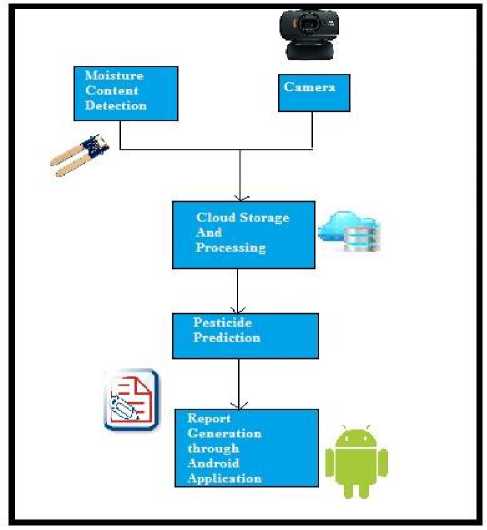
Fig.4. Block Diagram of AAFAMS
The report generated through an android application is manly for five crops. They are corn, eggplant, okra, tomato and soya bean. The information of how to use the application is provided in the option named how to use and information about the AAFAMS device is provided in the option named about AAFAMS. The report consists of the percentage of moisture content in the field, types of pests attacking the particular crop, pesticides to be applied to the pests that attack a particular crop, seasonal crops that can be grown in the field and the date and time when the report is generated. The month of the system is retrieved so as to fetch the information about the types of crops that are suitable for the particular season. These information are fetched when the option named Fetch report is selected for a particular crop. The images of pests are downloaded from the drop box cloud and saved in internal storage of android mobile in the folder named pests once the report is being fetched. Thus providing the facility of viewing the images of crops that are downloaded from the drop box cloud. The previously fetched report is available in the option named previous report.
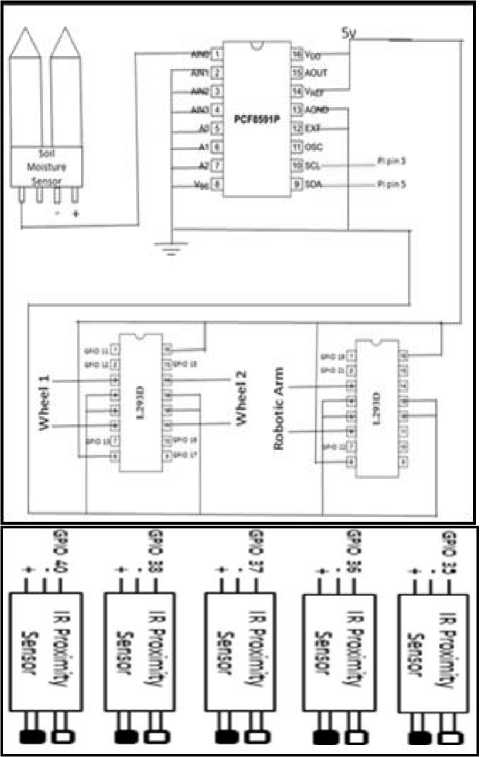
Fig.5. Circuit Diagram of AAFAMS
-
B. Implementation Phase
In implementation phase there are four phases:
Phase 1 : The IR Proximity sensor array has five sensors in which three sensors are used for line detection and other two are used for obstacle detection at the ends of the device as shown in the figure 5 Raspberry Pi receives 0 in all three sensors if it detects line else it receives 1.”Ref [7][8]”
If all three sensor values are 0 then the robot moves forward else if the left side sensor receives 1 and other two sensors receive 0 then only left wheels move so that the device turn little left and adjust itself to line and in the same way follows when right side sensor receives 1.
At last, if all three sensors receive 1 then it means there is no line further, and the Robotic Arm moves forward and checks moisture content in soil for 3 seconds.
Phase 2 : Soil Moisture sensor are the sensors which takes moisture content from soil and provides output in analog format, this output is given as input to 8bit AD/DA converter to convert it to digital format. This data will be sent to cloud for storage.
Phase 3 : Pest Detection where we must detect the pest in crops, to perform this we need to capture the video from camera and for every 10 seconds on the 5th second a frame of image from the video is extracted. This image is uploaded on cloud and processed.
Phase 4 : When all data are available in cloud a detailed report with average moisture contents, pests attacking the particular crop, pesticide for that crop, seasonal crops, date and time of the report generated will be available for farmer in the Android application. Using this information farmer will get to know about the field conditions and other information to help him in managing field effectively.
-
C. Advantages of Aafams over Some other Technologies
Technology has become a huge part in society and dayto-day life, and similarly modern ideas are filling the gaps between older technologies. The table 1 shows comparison AAFAMS with other technologies.
Table 1
|
AAFAMS |
Other Technologies |
||
|
1. |
Less Expensive: AAFAMS costs less expenses for required components. |
1. |
More Expensive: Costs more for the physical components which are required. |
|
2. |
User Friendly: The Android interface is very friendly in nature and it is easy to manage the device with less knowledge of the system. |
2. |
Complicated: These technologies need more knowledge of handling those devices which are not possible for a farmer. |
|
3. |
No Human Intervention: AAFAMS doesn’t require human intervention as it follows a line and automatically does its work. |
3. |
More Human Intervention: These technologies need more human intervention as these are mainly handled by humans themselves. |
|
4. |
Less Power Usage: This system uses less power usage and performs more efficiently. |
4. |
More Power Usage: These technologies need more power to work with and thereby reducing its efficiency. |
|
5. |
Solar Powered: AAFAMS has an additional solar power for charging battery. |
5. |
Battery Powered: These technologies are normally battery powered and needs frequent charging. |
|
6. |
Efficient Pest Detection: This system has more efficiency for detecting pest as it analyses the plants from ground level. |
6. |
Less Efficient: Other technologies try to detect pests from higher level from ground which has less efficiency of pest detection. |
-
VI. Conclusion
AAFAMS provides an effective and smarter way of monitoring the fields for farmers. It reduces the effort for the farmers by automating the analysis process and helps to detect pests in the fields and predicts pesticide which can be applied for these pests. This helps to increase the production capability of fields and maintains the fertility of the soil from water logging and prevents from applying more quantity of pesticides.
AAFAMS uses natural energy from sun through the solar panels which accumulate the energy to provide power supply and a clear report that is generated from the sensors and camera are displayed to the farmers through android application. In future work many other features can be added to the robot to find pH value of soil, detection of type of soil, predicting the type of crop that is to be grown in fields with respect to the type of soil and android application that generates report can be made in such a manner so as to translate the report in any language that the farmer is familiar.
Acknowledgments
The authors would like to thank the Editor, the Associate and anonymous reviewers for their valuable comments, which are very helpful for us to enhance our paper.
Список литературы Automated agricultural field analysis and monitoring system using IOT
- Dlodlo, N., & Kalezhi, J. (2015). The internet of things in agriculture for sustainable rural development 2015 International Conference on Emerging Trends in Networks and Computer Communications (ETNCC). doi:10.1109/etncc.2015.7184801
- Rupanagudi, S. R., S., R. B., Nagaraj, P., Bhat, V. G., & G, T. (2015). A novel cloud computing based smart farming system for early detection of borer insects in tomatoes. 2015 International Conference on Communication, Information & Computing Technology (ICCICT). doi:10.1109/iccict.2015.7045722
- Hiary, H. A., Ahmad, S. B., Reyalat, M., Braik, M., & Alrahamneh, Z. (2011). Fast and Accurate Detection and Classification of Plant Diseases. International Journal of Computer Applications, 17(1), 31-38. doi:10.5120/21832754.
- Tuli, A., Hasteer, N., Sharma, M., & Bansal, A. (2014). Framework to leverage cloud for the modernization of the Indian agriculture system. IEEE International Conference on Electro/Information Technology. doi:10.1109/eit.2014.6871748
- Singhpannu, G., Ansari, M. D., & Gupta, P. (2015). Design and Implementation of Autonomous Car using Raspberry Pi. International Journal of Computer Applications, 113(9), 22-29. doi:10.5120/19854-1789
- Bashish, D. A., Braik, M., & Bani-Ahmad, S. (2011). Detection and Classification of Leaf Diseases using Kmeans-based Segmentation and Neural-networks-based Classification. Information Technology Journal, 10(2), 267275. doi:10.3923/itj.2011.267.275
- Patil, P., H., V., Patil, S., & Kulkarni, U. (2011). Wireless Sensor Network for Precision Agriculture. 2011 International Conference on Computational Intelligence and Communication Networks. doi:10.1109/cicn.2011.169
- Kaewmard, N., & Saiyod, S. (2014). Sensor data collection and irrigation control on vegetable crop using smart phone. 2014 IEEE Conference on Wireless Sensors (ICWiSE). doi:10.1109/icwise.2014.7042670
- Miranda, J. L., Gerardo, B. D., & Iii, B. T. (2014). Pest Detection and Extraction Using Image Processing Techniques. International Journal of Computer and Communication Engineering,3(3), 189-192. doi:10.7763/ijcce.2014.v3.317
- https://www.growwater.org/plantneeds.html, March 2017.
- www.nbpgr.ernet.in, March 2017.
- Megha P Arakeri, Malavika Arun, Padmini R K“Analysis of Late Blight Disease in Tomato Leaf Using Image Processing Techniques I.J. I.J. Intelligent Systems and Applications, 2016, 9, 56-61 Published Online September 2016 in MECS (http://www.mecs-press.org/) DOI: 10.5815/ijisa.2016.09.07
- Kaushik Bhagawati*, Rupankar Bhagawati and Doni Jini ICAR Research Complex for NEH Region, Arunachal Pradesh Cen “Intelligence and its Application in Agriculture: Techniques to Deal with Variations and Uncertainties“I.J. Intelligent Systems and Applications, 2016, 9, 56-61 Published Online September 2016 in MECS (http://www.mecs-press.org/) DOI: 10.5815/ijisa.2016.09.07
- “Forecasting Cloudlet Development on Mobile Computing Clouds” Rashid G. Alakbarov, Fahrad H. Pashaev, Oqtay R. Alakbarov I.J. Education and Management Engineering, 2017, 5, 35-44 Published Online September 2017 in MECS DOI: 10.5815/ijitcs.2017.11.03
- EduCloud: A Dynamic Three Stage Authentication Framework to Enhance Security in Public Cloud G. Kumaresan, N.P. Gopalan I.J. Education and Management Engineering, 2017, 5, 35-44 Published Online September 2017 in MECS DOI: 10.5815/ijem.2017.06.02
- Development of Cloud Based Incubator Monitoring System using Raspberry Pi Mala Sruthi B, S. Jayanthy I.J. Education and Management Engineering, 2017, 5, 35-44 Published Online September 2017 in MECS DOI: 10.5815/ijeme.2017.05.04

